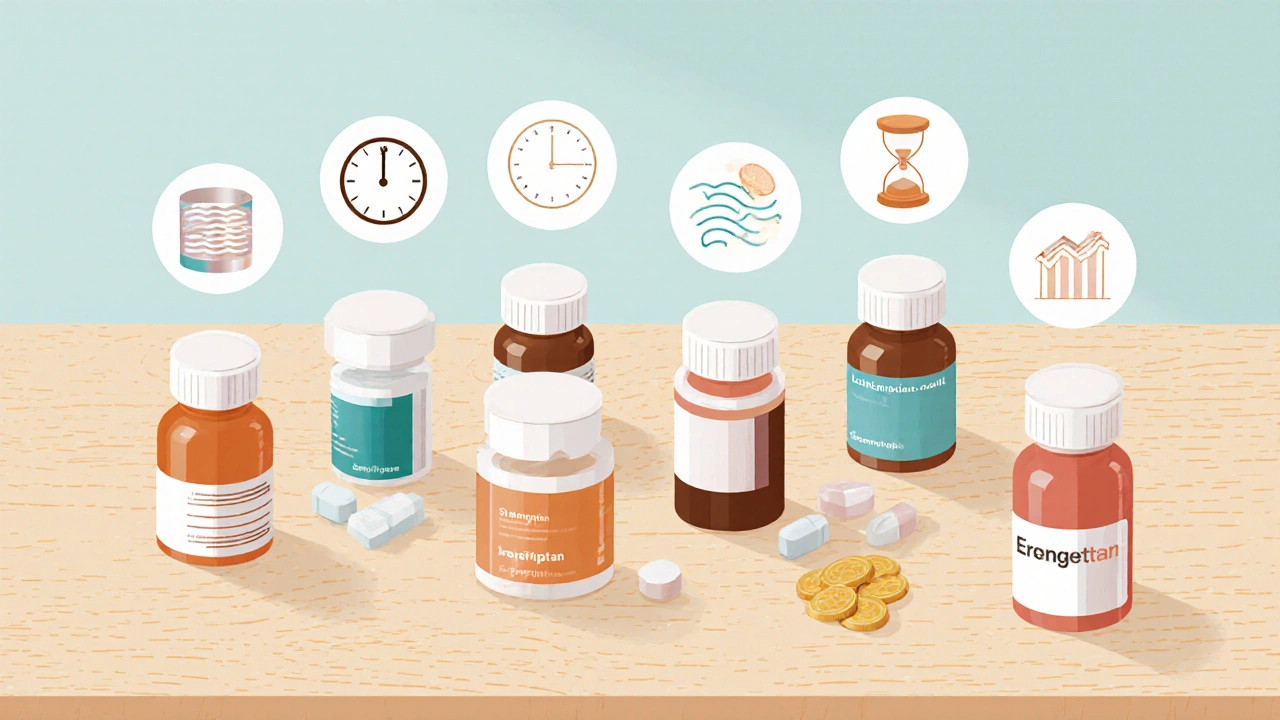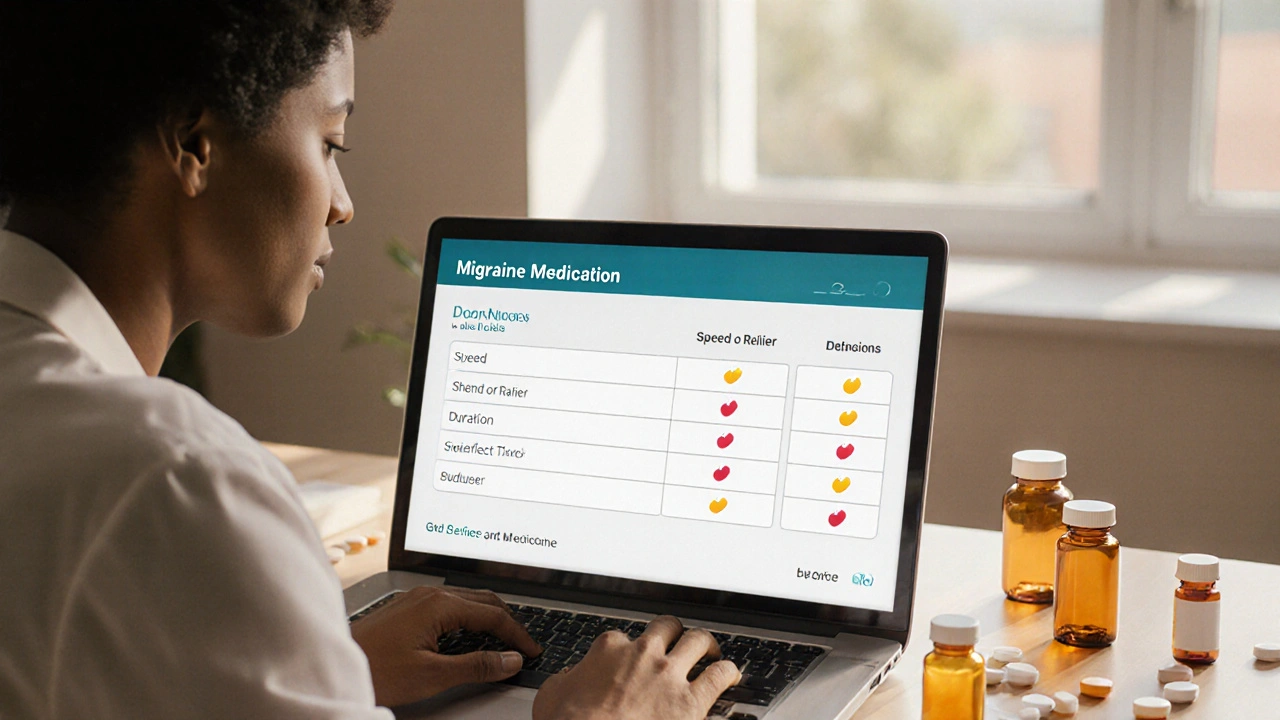Migraine Medication Comparison Tool
Select your preferences and click "Find Best Match" to see the recommended medication.
| Medication | Onset Time | Duration | Side Effects | Cost (NZD) |
|---|---|---|---|---|
| Rizact (Rizatriptan) | 30 min | 4-6 hrs | Tingling, Fatigue | $12-$15 |
| Sumatriptan | 45 min | 4-8 hrs | Warmth, Dizziness | $10-$13 |
| Eletriptan | 30 min | 8-12 hrs | Drowsiness, Dry Mouth | $14-$18 |
| Zolmitriptan | 15 min (spray) | 4-6 hrs | Nasal Irritation | $13-$16 |
| Naratriptan | 60 min | 12-24 hrs | Sleepiness, Constipation | $11-$14 |
| Frovatriptan | 45 min | 24+ hrs | Fatigue, Nausea | $15-$20 |
| Ubrogepant | 60 min | 6-8 hrs | Nausea, Fatigue | $30-$35 |
| Erenumab | Not applicable | 30-day coverage | Injection Site Redness | $350/month |
Key Takeaways
- Rizact (rizatriptan) works fast for moderate‑to‑severe migraine attacks and is taken as a single tablet.
- Sumatriptan and zolmitriptan offer similar efficacy but differ in onset time and side‑effect profile.
- Newer gepants (ubrogepant) and CGRP antibodies (erenumab) avoid vascular side effects, making them good for patients with heart concerns.
- Cost and insurance coverage vary widely; generic rizatriptan is usually the cheapest triptan.
- Choosing the right drug means balancing speed, duration, personal health history, and budget.
What Is Rizact?
When you see the name Rizact is a brand name for the triptan drug rizatriptan, used to treat acute migraine attacks. It was approved in the early2000s and quickly became popular because it starts to work in about 30minutes for many patients.
Rizact belongs to the triptan class, which works by narrowing blood vessels around the brain and blocking pain pathways. Its chemical structure allows a relatively quick absorption, making it a go‑to option for people who need relief before the pain peaks.
How Rizact Stacks Up Against Other Triptans
Traditional triptans have been the backbone of migraine therapy for decades. Below is a snapshot of the most common alternatives, each defined once with microdata so you can see the key facts at a glance.
Sumatriptan is the first triptan on the market, known for strong efficacy but a slightly slower onset (about 45minutes).
Eletriptan is a newer generation triptan that often works in 30minutes and has a longer duration of relief (up to 12hours).
Zolmitriptan is available as tablets and a nasal spray, offering a rapid onset (as quick as 15minutes with the spray).
Naratriptan is a slower‑acting triptan, typically taking 60-90minutes, but it lasts longer (up to 24hours) which can help with prolonged migraine episodes.
Frovatriptan is the longest‑acting triptan, with a half‑life of about 26hours, making it useful for menstrual‑related migraines.
Ubrogepant is a gepant, a non‑triptan acute migraine drug that works without causing blood‑vessel constriction.
Erenumab is a CGRP monoclonal antibody administered once a month for migraine prevention, not an acute treatment but often discussed as an alternative when triptans aren’t tolerated.

Side‑Effect Profiles: What to Expect
Every medication has pros and cons. Here’s a quick look at common side effects for each option.
- Rizact: Tingling, fatigue, mild nausea. Rarely causes chest tightness.
- Sumatriptan: Warmth, dizziness, possible serotonin syndrome when combined with certain antidepressants.
- Eletriptan: Drowsiness, dry mouth, occasional heart palpitations.
- Zolmitriptan: Nasal irritation (spray), taste disturbance, mild headache rebound.
- Naratriptan: Sleepiness, constipation, mild muscle aches.
- Frovatriptan: Fewest immediate side effects, but can cause fatigue lasting several hours.
- Ubrogepant: Nausea and fatigue are the most reported, but no vascular effects.
- Erenumab: Injection site redness, constipation, occasional hypertension.
If you have a history of heart disease, the non‑vascular drugs (ubrogepant, erenumab) are worth discussing with your doctor.
Cost & Availability in NewZealand (2025)
Price matters, especially if you need a rescue medication multiple times a month.
| Drug | Typical Onset | Duration of Relief | Common Side Effects | Typical Dose | Prescription? | Approx. Cost |
|---|---|---|---|---|---|---|
| Rizact | 30min | 4-6hrs | Tingling, fatigue | 10mg tablet | Yes | $12-$15 |
| Sumatriptan | 45min | 4-8hrs | Warmth, dizziness | 50‑100mg tablet | Yes | $10-$13 |
| Eletriptan | 30min | 8-12hrs | Drowsiness, dry mouth | 40mg tablet | Yes | $14-$18 |
| Zolmitriptan | 15min (spray) | 4-6hrs | Nasal irritation | 5mg tablet or 5mg spray | Yes | $13-$16 |
| Naratriptan | 60min | 12-24hrs | Sleepiness, constipation | 2.5mg tablet | Yes | $11-$14 |
| Frovatriptan | 45min | 24hrs+ | Fatigue, mild nausea | 2.5mg tablet | Yes | $15-$20 |
| Ubrogepant | 60min | 6-8hrs | Nausea, fatigue | 50mg tablet | Yes | $30-$35 |
| Erenumab | Not applicable (prevention) | 30‑day coverage | Injection site redness | 70mg injection | Yes (special approval) | $350 per month |
Because NewZealand’s PHARMAC program subsidizes many generic triptans, you’ll often see a lower out‑of‑pocket cost for rizatriptan compared with brand‑only options like eletriptan.
Choosing the Right Option for You
Here’s a quick decision guide. Answer the questions below, then match your answers to the drug that fits best.
- Do you need fast relief (under 30minutes)? - Zolmitriptan nasal spray or Rizact are top picks.
- Do you have cardiovascular risk factors? - Consider ubrogepant or erenumab, which don’t constrict vessels.
- Is cost your primary concern? - Generic rizatriptan and sumatriptan are usually cheapest.
- Do you experience migraines that last longer than 12hours? - Naratriptan or frovatriptan’s longer duration can help.
- Do you prefer a single‑dose solution for menstrual migraines? - Frovatriptan’s long half‑life works well.
If you tick multiple boxes, talk to your GP about a personalized plan. Often doctors will start you on a generic triptan (like Rizact) and switch only if you encounter intolerable side effects.
And if you’re wondering whether Rizact is the best first‑line choice, the answer is: for most people who need quick relief without a history of heart disease, it’s a solid, cost‑effective option.

Potential Pitfalls and How to Avoid Them
- Medication overuse headache: Using any acute migraine drug more than 10 days a month can worsen headaches. Keep a diary.
- Drug interactions: Triptans should not be combined with MAO‑inhibitors or certain SSRIs. Always list all current meds to your prescriber.
- Timing of doses: Taking Rizact too early (before the aura starts) may reduce its effectiveness. Aim for the first noticeable pain.
- Allergy concerns: Rare but possible. If you develop a rash or swelling, stop the drug and seek medical advice immediately.
Frequently Asked Questions
How quickly does Rizact start working?
Most people feel relief within 30minutes, with peak effect around the 1‑hour mark.
Can I take Rizact with my birth control pills?
Yes, birth control pills do not interact with rizatriptan. However, always double‑check with your pharmacist if you’re on other hormonal treatments.
Is there a risk of serotonin syndrome with Rizact?
The risk is low but not zero. If you’re on SSRIs, SNRIs, or MAO‑inhibitors, discuss dosage adjustments with your doctor.
What should I do if Rizact doesn’t relieve my migraine?
You can take a second dose after at least 2hours, but avoid exceeding 30mg total per day. If it still fails, consider a different triptan or a gepant like ubrogepant.
Are there non‑prescription options that work as well as Rizact?
Over‑the‑counter NSAIDs (ibuprofen, naproxen) can help mild attacks, but they don’t target the migraine pathway like triptans. For moderate‑to‑severe migraines, a prescription triptan remains the most effective choice.
Next Steps
1. **Record your migraine pattern** - note onset time, severity, and triggers. 2. **Schedule a brief appointment** with your GP or neurologist. Bring your diary and ask specifically about rizatriptan versus other options. 3. **Check your insurance or PHARMAC coverage** - ask the pharmacy for the cheapest generic version. 4. **Trial period** - if you start with Rizact, give it a week of consistent use before deciding it’s not right. 5. **Re‑evaluate** - if side effects or insufficient relief persist, discuss switching to a different triptan or a gepant.
By understanding the strengths and limits of each medication, you can turn migraine days into manageable moments rather than a daily nightmare.

Carlise Pretorius
i've been using rizact for a few months now and i love how fast it hits i usually feel relief around the half hour mark it’s super convenient especially when i’m at work and cant afford a long downtime
Johnson Elijah
Great rundown! 🙌 If you need ultra‑quick relief, the nasal spray version of zolmitriptan is unbeatable, but rizact is a solid everyday go‑to. 👍
Roxanne Lemire
the philosophical angle here is interesting it raises the question of whether we chase speed or sustainability in migraine care perhaps the ideal is a balance where the drug works swiftly yet lasts long enough to prevent rebound headaches
Alex Mitchell
Totally agree with the balance idea – it’s like finding the sweet spot between a sprint and a marathon when managing pain 🙂
Narayan Iyer
From a pharmacoeconomic standpoint, generic rizatriptan (rizact) offers a favourable cost‑effectiveness ratio, especially in health systems where budget constraints dictate formulary decisions. The bioavailability and receptor affinity profile also support its rapid onset, making it a viable first‑line option for clinicians handling diverse patient cohorts.
Amanda Jennings
Loving the practical tips! It’s nice to see real‑world guidance that doesn’t drown you in jargon – just plain advice we can actually use.
alex cristobal roque
When it comes to picking the right migraine rescue medication, there are several factors that deserve a deep dive. First, the speed of onset is paramount for many sufferers because the longer the pain lingers, the more it interferes with daily activities and overall quality of life. Rizact (rizatriptan) typically begins to work within thirty minutes, which places it in the fast‑acting category, though not the absolute fastest – that title often goes to the nasal spray form of zolmitriptan, which can act in as little as fifteen minutes. Second, the duration of relief matters; while rizact provides relief for four to six hours, some patients may experience a return of symptoms after that window, prompting a need for either a second dose or a medication with a longer half‑life, such as frovatriptan, which can last up to twenty‑four hours. Third, side‑effect profiles cannot be ignored – the tingling and fatigue reported with rizact are generally mild, but patients with cardiovascular risk factors should be cautious, as triptans constrict blood vessels. Fourth, cost is a practical reality; in many markets, generic rizatriptan is among the most affordable triptans, often costing between twelve and fifteen dollars per dose, making it accessible for patients who need to use rescue medication multiple times per month. Fifth, drug interactions are a key consideration – combining triptans with MAO‑inhibitors or certain SSRIs can increase the risk of serotonin syndrome, so a thorough medication review is essential. Sixth, patient preference for administration route – some patients dislike swallowing pills and may prefer the intranasal spray formulation of zolmitriptan for its rapid onset and ease of use during a migraine attack. Seventh, the role of newer classes of medications, such as gepants (e.g., ubrogepant) and CGRP monoclonal antibodies (e.g., erenumab), provides alternatives for patients who cannot tolerate triptans or who have contraindications due to cardiac issues. Eighth, the phenomenon of medication‑overuse headache reminds clinicians to limit acute medication use to fewer than ten days per month to avoid worsening headache patterns. Ninth, the timing of dosing relative to aura onset – taking rizact at the first sign of pain, rather than waiting for the full headache, can improve effectiveness. Tenth, insurance coverage and formulary placement can dictate which medications are viable options for a given patient. Eleventh, real‑world evidence suggests that many patients start with a generic triptan like rizact and only switch if they experience inadequate relief or intolerable side effects. Twelfth, patient education on proper use, including the possibility of a second dose after two hours if needed, empowers individuals to manage their condition more effectively. Thirteenth, clinicians should consider comorbid conditions such as depression or anxiety, which may influence medication choice. Fourteenth, the emerging data on combination therapy – using a triptan with an NSAID – can provide synergistic relief for some patients. Fifteenth, the importance of maintaining a headache diary cannot be overstated; it helps both patient and provider identify patterns, triggers, and the most effective medication. In summary, while rizact offers a solid balance of speed, cost, and tolerability for many patients, the ultimate choice should be individualized based on clinical profile, patient preferences, and economic considerations.
Bridget Dunning
Dear colleague, I appreciate the exhaustive exposition presented above. Your methodical enumeration of pharmacological considerations aligns with best‑practice guidelines and demonstrates commendable scholarly rigor. While the discourse is thorough, I would like to underscore the significance of integrating patient‑reported outcome measures (PROMs) in therapeutic decision‑making, as these instruments capture dimensions of efficacy that extend beyond mere temporal metrics. Moreover, the evolving evidence base regarding CGRP antagonists warrants a cautious yet optimistic appraisal, particularly in patients with refractory migraine phenotypes. I trust this modest addition will enrich the ongoing dialogue.
Shweta Dandekar
It is absolutely imperative, with due respect, to consider ethical prescribing practices, especially when dealing with potent vasoconstrictive agents, such as triptans, which may pose significant risks to certain patient populations.
Gary Smith
Listen, if you’re not taking a drug that’s made in America, you’re basically selling out, and nobody wants that, so stick to the homegrown options, period.
Dominic Dale
We have to ask ourselves why the mainstream medical community is so quick to push triptans without mentioning the hidden agenda of pharmaceutical conglomerates. The data they release is carefully curated to hide the fact that long‑term use of these vasoconstrictors can subtly rewire your vascular system, making you more dependent on their products. Have you ever noticed how the same doctors who prescribe rizact also appear on glossy advertisements? That’s no coincidence. The real story is that there’s an entire network of lobbyists ensuring that alternative, non‑patented treatments are suppressed. Trust me, if you look at the patent expiration dates and the timing of new drug releases, you’ll see a pattern that suggests a coordinated effort to keep the market saturated with pricey brand‑name options, while generic versions are pushed just enough to keep the illusion of choice. And remember the micro‑dosing trend – it’s being quietly promoted online as a way to sidestep the big pharma narrative, but the industry is already working on a counter‑campaign to discredit any data that supports non‑triptan therapies. Stay vigilant.
christopher werner
I understand the concerns raised, however it is essential to base our treatment choices on vetted clinical evidence and peer‑reviewed studies rather than unverified speculation.
Matthew Holmes
Picture this: a hidden cabal of pharma execs pulling strings behind the curtains, dictating which migraine meds you can even read about, while the rest are locked away in secret vaults. It’s like a thriller movie, but it’s real life.
Patrick Price
i think you all missed the point its not about the drug its about how much coffee i drink during attacks u know
Travis Evans
Keep pushing forward! Whether you land on rizact or a newer gepant, the goal is to get back to the things you love faster.
Jessica Hakizimana
Every step you take toward understanding your migraine triggers and treatment options is a victory – stay hopeful and keep sharing your journey with the community.
peter derks
Thanks everyone for the insights – I’ll take this into my next appointment and see which option fits best.